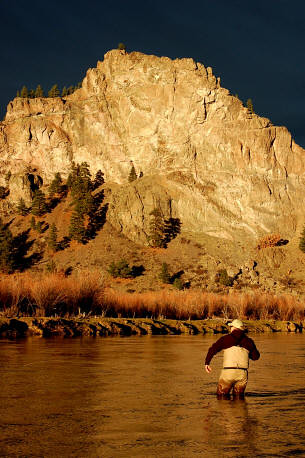 Yes, it is. The trout make the ultimate decision. The Missouri is an excellent teacher. It rewards anglers for proper and appropriate techniques. If the fish does not eat the fly, it is not his fault. It's your fault. And it may not be the fly. Most commonly it is not the fly...it is probably your drift.
Yes, it is. The trout make the ultimate decision. The Missouri is an excellent teacher. It rewards anglers for proper and appropriate techniques. If the fish does not eat the fly, it is not his fault. It's your fault. And it may not be the fly. Most commonly it is not the fly...it is probably your drift.Our fish do not recognize flies that they do not see. If the fish are eating Trico Spinners and your fly happens to be 1 ft from the fish, he may not eat it. That is a learning tool. Keep in mind that spinners are dead and they do not move contrary to the current. So...drift is KING on the Missouri. Most of the fish are eating dead bugs all day long. Dead bugs do not possess the drag quotient.
A reach casts is the prevalent cast. Any type of slack line presentation is a good starting point. Whether you like to through a S-Cast, Reach, Fall River type of drift, or any sloppy downstream slack-line presentation you desire. Send and Mend my Friend, you will find success.
Failure is a learning tool. Fly fishing is a great sport because it immediately lets you know if you have executed the cast and drift correctly... every single presentation or drift. If the fish did not respond, change something. Not your fly. Get the fly first, not behind or upstream of the leader or tippet. Remember: The first cast and drift is the one you want to hook the fish with.
If you do not succeed with perfect drifts over the fish, not in the Tri-County region, on the fish...then consider changing the fly. Most fish will eat nearly anything perfectly drifted over them. This is not an absolute rule, but does hold water.
One last comment about great drifts and catching fish. Do not cast long, or over/beyond the fish. Try to remove as many things that will promote failure. First: Not having too much line at your feet or on the deck allowing you to make a cast that lines the fish. If you have 55ft. of line off the reel and are only casting 25ft to the fish...there is room for error. Eliminate it. Second: Make sure you have enough line out. Meaning, if you are casting at a fish 25ft away and you only have 20ft of line off the reel...you will have to strip and send during the drift taking yourself out of the game. Doing this usually hitches or drags the fly several times during the drift and spooking the fish...or...the fish eats the fly and we are not ready to strike. Both undesirable outcomes. Eliminate things that can hinder success.
Make a couple practice casts beside the fish allowing yourself to understand the currents and micro-currents that may affect the drift. This also allows you to have the correct amount of line out. Now just inch over to the target. It may take several casts. That is OK. The fish may move to the fly, so let him make that decision. If it is perfectly drifted it may happen. If it is dragging, forget about it. Primarily this time of year when they are eating small dead stuff. July, dragging, yes they may inhale it, but August...No.
Use Failure as a Learning Tool...Humility is not a negative outcome. Use it to your advantage and get better. Fly Fishing is a lifetime sport. Catching fish is only one of the multitude of reasons we pursue this passion, piss off our spouses, and spend far too much money on this crazy behavior...just to put the beautiful, wonderful creature back into the water and reflect on how truly privileged and fortunate we are to reside on Mother Earth.
The bite of the wind off the water. The hum of the mosquitoes buzzing past. The brilliant green of the canopy of nearby trees. The earthy aroma of the water. Fishing is a sport that engages all of the senses.
Unknown Author
Unknown Author



No comments:
Post a Comment